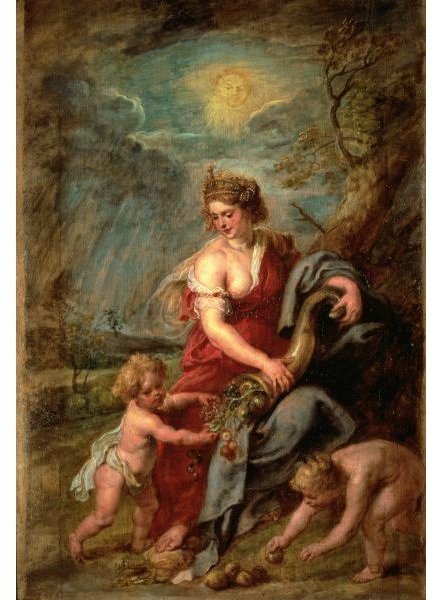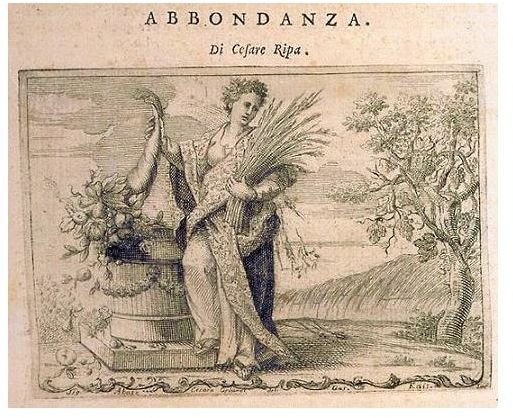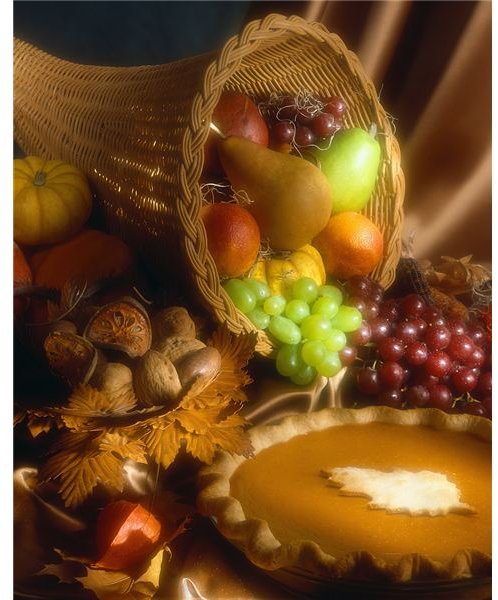A Look into Cornucopia History: The Meaning Behind the Horn of Plenty
A Latin Translation
We have all come to recognize the cornucopia as a symbol of Thanksgiving or the fall harvest and many of us use one to decorate our
dining room tables as the centerpiece to our traditional feast. There is more, however, to this horn-shaped figure than meets the eye. Its name, entered into the English dictionary in 1508, originates from two Latin words; Cornu meaning “horn” and Copia meaning “plenty”. Hence the nickname Horn of Plenty, which in most cases today refers to an abundance of something. (i.e., there is a cornucopia of ideas coming from the volunteers.)
In ancient times and in cases associated with Thanksgiving, it refers to a horn-shaped basket or hallowed out gourd filled with fruits and vegetables gathered from a good harvest and sometimes may contain flowers for added beauty.
As Greek Folklore Has It…

There are two legends associated with the cornucopia or Horn of Plenty as it is defined that dates back to 5th century B.C. Below are two shortened versions of the legends.
Amalthea and Zeus
According to ancient Greek mythology, Amalthea was a goat who nursed and raised Zeus from an infant, while in hiding from his father, Cronos, up in the mountains of Crete. She nursed him with her milk and ensured his safety in order for him to one day become a powerful god.
One day, while playing around, Zeus accidentally broke one of Amalthea’s horns. In his remorse, he decided to repay her by using his godly powers to ensure the horn to be always filled with whatever Amalthea wished - eternal abundance. Hence the coining of the symbolic Horn of Plenty or cornucopia.
Amalthea’s Horn and Hercules
This version of the myth tells of Hercules who is the son of the Greek god Zeus, who finds himself in a battle with Achelous, god of the river, to win the heart of Deianira, a beautiful maiden and the daughter of King Aeneus. According to legend, Achelous transformed himself into several creatures during the battle as part of his strategy to beat Hercules. As he was being held to the ground, he transformed himself first into a serpent, then a bull. Hercules, however, overtook him and eventually broke off one of his horns. Achelous then turned back into his god-like form, and returned to the river, therefore being defeated by Hercules.
The beautiful maiden Deianira and Hercules kept the horn of Achelous and filled it with fruits and flowers to be presented in celebration of their marriage.
There is a slightly different version that depicts how Hercules was Zeus’s son and therefore owner of Amalthea’s Horn of Plenty, and after battle with Achelous and feeling guilty for breaking off his horn, he gave him the Horn of Amalthea as a peace-offering.
Art Depictions and Religious Symbols

Greek mythology was often the center of European paintings including those that depicted the Horn of Plenty. Often times it was represented as a goat’s horn (from the original myth itself) and often was seen being held by several different deities. (i.e. Tyche or Fortuna - goddess of riches and prosperity) It usually appears in two positions; one with the mouth or opening facing upwards and one facing downwards, depending on the deity being portrayed and the artist.
The cornucopia or adaptations of it have been embossed in Jewish coins within the Maccabean era, used to bless kings and royalty, were found on seals and some buildings and even were used as religious musical instruments.
Fun Facts on the Cornucopia
Here are some more facts about cornucopias that are entrenched in today’s culture:
- Cornucopias are made from all types of materials including metal, wood, ceramics, stone and, most commonly, wicker for baskets.
- Cornucopias are sold at garden centers, gift shops, and craft stores and can also be found at garage sales and thrift shops.
- Today a cornucopia may contain fruits, vegetables, nuts, grains and breads, or leaves, flowers or even cattail.
- It is used today as a symbol on the Peru, Wisconsin and Idaho flags
- There is a mushroom named for its “Horn of Plenty” shape called Craterellus Cornucopiodes, otherwise known as the Black Trumpet.
- There is an indulgent wine and food festival named Cornucopia (after its abundance of lavish food and wine tastings), that occurs every November in Whistler, British Columbia.
- The “waffle cone” was named the St. Louis World’s Fair’s Cornucopia back in 1904 for its conical/horn-like shape.
A Thanksgiving Toast
Over the years, the cornucopia has been symbolic of prosperity, good fortune, fertility, and abundance of resources and Nature’s gifts. Whether it is through art, history, religion or culture, this emblem has been depicted as much more than a simple but bountiful decoration at Thanksgiving time. It has become a symbol of American’s thankfulness for all of the good things life has brought to them. Next time you are toasting to good health and fortune on Thanksgiving Day, you may just want to have one close by for good luck!
References
- Beck, Allison. A History of the Cornucopia, http://www.thedailymeal.com/history-cornucopia
- Image: Abundance by unknown under the public domain
- Bruno, Gwen. The Cornucopia: Symbol of the Harvest, http://davesgarden.com/guides/articles/view/2705/#b
- What Does the Cornucopia Symbolize? http://www.inspirationline.com/Brainteaser/cornucopia.htm
- Image: Cornucopia - Abbondanza by Cesare Ripa under public domain
- Peru Flag, http://www.flags-flags-flags.org.uk/peru-flag.htm
- Cornucopia Wine and Food Festival, http://whistlercornucopia.com/
- Archaeology, Mythology and History of Crete: Amalthea, http://www.explorecrete.com/mythology/amalthea.html
- Legends and Short Stories to Share for Thanksgiving: The Horn of Plenty, http://www.apples4theteacher.com/holidays/thanksgiving/short-stories/the-horn-of-plenty.html
- The Cornucopia in Greek Myth, http://www.mythphile.com/2010/11/the-cornucopia-horn-of-plenty-in-greek-myth/
